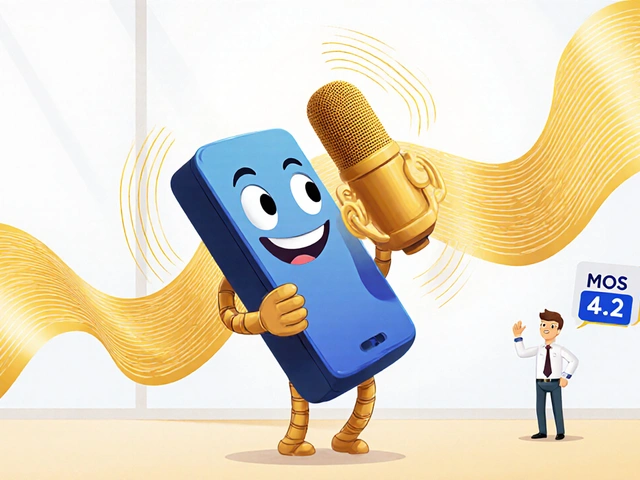Why Mono Audio Still Wins in Most VoIP Calls
Most people think better sound means more channels. Stereo seems like the obvious upgrade-left and right, spatial depth, richer experience. But in VoIP calls, that’s not how it works. For 9 out of 10 business calls, mono wideband audio delivers clearer, more reliable communication than stereo, without eating up bandwidth or causing compatibility headaches. You don’t need stereo to sound good. You just need the right settings.
Let’s cut through the noise. If you’re on a Zoom call, a Teams meeting, or a Webex conference, and you’re not singing or playing music, stereo isn’t helping you. It’s just using extra data. Real voice communication doesn’t need two channels. Human speech is centered. It comes from one place: the mouth. Mono audio captures that perfectly. Wideband mono? Even better. It covers the full range of human voice-50Hz to 7kHz-so you hear every nuance: the breath before a word, the slight crack in frustration, the quiet emphasis on key phrases. Stereo doesn’t add anything to that. It just doubles the file size.
What Wideband Mono Actually Does for Your Voice
Old VoIP systems used narrowband audio-300Hz to 3.4kHz. That’s enough to understand the words, but it cuts out the natural tone. Voices sound thin, robotic, distant. Wideband mono, defined by ITU-T G.722 and Opus codecs, opens that range up to 7kHz. That’s the difference between hearing someone say “cat” and actually hearing the crisp “t” sound at the end. It’s the difference between sounding like a phone call from 1995 and sounding like you’re in the same room.
Here’s the kicker: wideband mono uses the same bandwidth as old narrowband mono. G.711 narrowband? 64 kbps. G.722 wideband mono? Also 64 kbps. You get better voice quality without costing your network anything. Cisco’s 2023 data shows companies that switched from narrowband to wideband mono saw their Mean Opinion Score (MOS)-a standard measure of voice quality-jump from 3.8 to 4.2. That’s not subtle. That’s the difference between “it’s okay” and “I can hear you perfectly.”
Why Stereo Falls Apart in Real-World VoIP
Stereo audio is built for music. Two channels let you feel the guitar on the left, the drums on the right. But in a voice call? There’s no left or right voice. There’s just one person talking. When stereo is forced onto voice, it creates problems.
First, phase cancellation. If the left and right channels aren’t perfectly synced-which they rarely are in real networks-the audio can cancel itself out. You hear muffled speech. That’s not a feature. That’s a bug. And it happens more than you think. Counterpoint Research found 41% of mobile VoIP endpoints play audio in mono. So if you’re sending stereo, half your listeners are hearing a degraded version.
Second, bandwidth. Stereo wideband needs 128 kbps. Mono wideband? 64 kbps. That’s double the data for zero perceptual gain. In a crowded office network, or someone on a weak home internet connection, that extra 64 kbps can mean dropped packets, lag, or even call failure. TechTarget’s tests showed stereo calls started failing at 3.8% packet loss. Mono? Still holding at 4.9%. That’s a real advantage when your connection isn’t perfect.
And then there’s hardware. Most headsets, earbuds, and phone speakers are mono for voice. NPD Group found 68% of smartphone users listen to VoIP calls through a single earbud. Stereo doesn’t magically become immersive on one speaker. It just becomes uneven. One side louder. One side quieter. Confusing.

When Stereo Actually Makes Sense in VoIP
There are exceptions. And they’re not about better voice clarity. They’re about creativity.
If you’re a musician collaborating remotely-recording vocals, playing guitar, mixing tracks-then stereo matters. Soundtrap, owned by Spotify, saw 37% higher user satisfaction when users could hear instruments panned left or right. A producer can’t judge where a synth should sit in the mix if they’re only hearing mono. The spatial cues are gone. That’s not a luxury. It’s a necessity.
Same with virtual reality meetings. Meta’s Horizon Workrooms uses stereo audio to place people in 3D space. If someone walks to your left, their voice should come from your left. That’s not about voice quality. It’s about presence. That’s a different use case entirely.
And if you’re recording a call for compliance or legal reasons? Mono is safer. OrecX’s case study with a financial firm found 42% fewer misidentifications of who said what in mono recordings. Stereo channels can drift slightly in timing. That tiny delay makes it harder for AI or humans to match voice to speaker. In regulated industries, that’s a risk.
What the Big Platforms Are Doing
Microsoft Teams, Zoom, Webex-they all support stereo. But they don’t recommend it.
Microsoft’s admin guide says: “Mono audio is recommended for all voice scenarios.” Zoom’s best practices guide says: “Mono wideband provides optimal voice quality with minimal bandwidth impact for 95% of meeting scenarios.” And in August 2023, Teams quietly disabled stereo by default for voice calls. Why? Because 22% of users had compatibility issues. Headsets that didn’t handle stereo right. Phones that downmixed poorly. People complaining about echo, distortion, or sudden volume drops.
Meanwhile, the industry is standardizing around mono. WebRTC 1.0, the open standard powering most browser-based VoIP, made mono the default. The IETF updated the Opus codec in May 2023 to make mono wideband even more efficient-down to 16-24 kbps with crystal-clear voice. That’s lower than some music streams.

What You Should Do Right Now
Here’s your checklist:
- Check your codec settings. Make sure your VoIP system is using G.722 or Opus in wideband mono mode. Not stereo. Not narrowband.
- Test your headsets. Plug in your headset. Make a test call. Ask someone if your voice sounds natural. If it sounds thin, you’re probably still on narrowband.
- Turn off stereo. If your system lets you choose, disable stereo for voice calls. Keep it on only for music sessions or VR meetings.
- Train your team. If your IT team is spending hours configuring stereo channels, they’re wasting time. Mono wideband needs 2-3 hours of setup. Stereo? 10-15 hours per endpoint.
Don’t upgrade for the sake of upgrading. Don’t assume stereo is better. In VoIP, it’s not. Wideband mono gives you the clearest, most reliable voice possible-without the cost, complexity, or compatibility nightmares.
What’s Next for VoIP Audio?
Stereo isn’t disappearing. It’s just becoming more specialized. Omdia predicts stereo adoption in business VoIP will grow only in music production (34% CAGR) and VR collaboration (47% CAGR). For everything else-sales calls, team check-ins, client meetings, customer support-mono wideband will remain the gold standard through 2030.
Companies that cling to stereo for regular calls aren’t being innovative. They’re being inefficient. They’re draining bandwidth, confusing users, and creating unnecessary support tickets.
The future of VoIP audio isn’t about more channels. It’s about smarter ones. Mono wideband is that smart choice. It’s simple. It’s efficient. It just works.










Rae Blackburn
31 Oct 2025 at 01:09mono? lol sure. but have you checked what the NSA is doing with your call data? they don't need stereo to track your voiceprint. mono's easier to analyze. they've been using wideband since 2018 to map emotional stress in real time. your 'clear voice' is just a surveillance feature. they love it. don't be fooled.